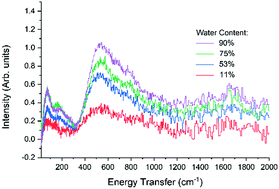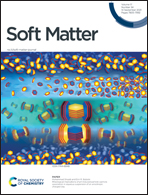Interfacial water morphology in hydrated melanin†
Abstract
The importance of electrically functional biomaterials is increasing as researchers explore ways to utilise them in novel sensing capacities. It has been recognised that for many of these materials the state of hydration is a key parameter that can heavily affect the conductivity, particularly those that rely upon ionic or proton transport as a key mechanism. However, thus far little attention has been paid to the nature of the water morphology in the hydrated state and the concomitant ionic conductivity. Presented here is an inelastic neutron scattering (INS) experiment on hydrated eumelanin, a model bioelectronic material, in order to investigate its ‘water morphology’. We develop a rigorous new methodology for performing hydration dependent INS experiments. We also model the eumelanin dry spectra with a minimalist approach whereas for higher hydration levels we are able to obtain difference spectra to extract out the water scattering signal. A key result is that the physi-sorbed water structure within eumelanin is dominated by interfacial water with the number of water layers between 3–5, and no bulk water. We also detect for the first time, the potential signatures for proton cations, most likely the Zundel ion, within a biopolymer/water system. These new signatures may be general for soft proton ionomer systems, if the systems are comprised of only interfacial water within their structure. The nature of the water morphology opens up new questions about the potential ionic charge transport mechanisms within hydrated bioelectronics materials.



 Please wait while we load your content...
Please wait while we load your content...